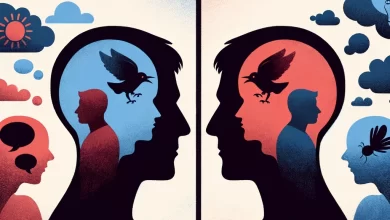Understanding PTSD Symptoms and Triggers
Have you ever wondered what signs to look for in someone experiencing post-traumatic stress disorder (PTSD)? How do you identify the symptoms and triggers that can disrupt their daily life and well-being?
PTSD is a mental health condition that can arise after a person has lived through a terrifying event. It can affect anyone, from soldiers returning from war zones to survivors of natural disasters or accidents. Understanding the symptoms and triggers of PTSD is crucial in providing support and helping individuals on their journey towards recovery.
Key Takeaways:
- PTSD is a mental health condition triggered by a traumatic event.
- Symptoms of PTSD include flashbacks, nightmares, severe anxiety, and uncontrollable thoughts.
- PTSD symptoms can be grouped into four types: intrusive memories, avoidance, negative changes in thinking and mood, and changes in physical and emotional reactions.
- Triggers for PTSD can vary and may involve external sensory stimuli or internal thoughts and emotions.
- Early intervention and seeking help from mental health professionals are crucial in managing and treating PTSD.
Intrusive Memories
Intrusive memories are a common symptom of post-traumatic stress disorder (PTSD). Individuals with PTSD may experience recurrent and distressing memories of the traumatic event, often referred to as intrusive memories. These memories can be intrusive, vivid, and overwhelming, causing significant emotional distress and impacting daily functioning.
One form of intrusive memory is experiencing flashbacks. Flashbacks are involuntary and intense recollections of the traumatic event that can occur at any time. During a flashback, individuals may feel as if they are reliving the event, with vivid sensory experiences and a sense of being trapped in the past.
Flashbacks often involve a loss of connection with the present moment, as the individual’s mind and body react as if the trauma is happening in real-time.
In addition to recurrent memories and flashbacks, PTSD can also manifest in disturbing dreams or nightmares related to the traumatic event. These nightmares can be vivid and emotionally intense, frequently causing significant distress and sleep disturbances for individuals with PTSD.
Nightmares associated with PTSD can be so distressing that they may disrupt normal sleep patterns, contribute to sleep deprivation, and intensify other PTSD symptoms.
When triggered by reminders of the traumatic event, individuals with PTSD may experience severe emotional distress or physical reactions. Even seemingly unrelated stimuli, such as sights, sounds, smells, or certain situations, can elicit intrusive memories and intensify the emotional impact of PTSD.
For example, a loud noise resembling the sound of gunfire may trigger a flashback in a combat veteran, causing an overwhelming emotional response and physical sensations associated with the original trauma.
To illustrate the prevalence of intrusive memories, flashbacks, and nightmares in individuals with PTSD, consider the following table:
| Type of Symptom | Prevalence |
|---|---|
| Intrusive Memories | 90% |
| Flashbacks | 80% |
| Nightmares | 70% |
Avoidance
Avoidance is a common symptom experienced by individuals with post-traumatic stress disorder (PTSD). When confronted with reminders of a traumatic event, individuals may instinctively avoid these triggers as a means of self-preservation. This avoidance can manifest in several ways and significantly impact their daily functioning and relationships.
Avoiding Traumatic Event Reminders
One aspect of avoidance in PTSD involves actively avoiding reminders of the traumatic event.
“I can’t bear the thought of reliving that experience. I do everything I can to avoid anything that reminds me of what happened.” – Sarah, PTSD survivor
These reminders can include places, people, activities, or even certain thoughts or conversations that evoke memories of the traumatic event. By avoiding such triggers, individuals hope to prevent the reemergence of distressing emotions and memories.
However, while avoidance may offer temporary relief, it can also perpetuate the cycle of fear and anxiety associated with PTSD. By continually avoiding triggers, individuals inadvertently reinforce the belief that these reminders and the associated emotions are unbearable, which can hinder their progress in healing and recovery.
The Impact on Daily Functioning and Relationships
Avoidance can significantly impact various areas of an individual’s life, including their daily functioning and relationships.
In terms of daily functioning, individuals with PTSD may find themselves limited in the activities they can engage in and the places they can visit due to their efforts to avoid triggers. This may result in a restricted lifestyle and a diminished sense of freedom and spontaneity.
In relationships, avoidance behaviors can strain connections with loved ones. Avoiding conversations about the trauma or specific triggers can lead to a breakdown in communication and understanding between the individual with PTSD and their support system. It may also create distance and isolation, as the individual tries to shield themselves from potential reminders while unintentionally pushing away those closest to them.
Recognizing the impact of avoidance on daily life and relationships is a crucial step in understanding and addressing PTSD symptoms. By working through avoidance and gradually engaging with triggers in a safe and controlled manner, individuals can learn to manage their PTSD more effectively and regain control over their lives.
Negative Changes in Thinking and Mood
Individuals with PTSD often experience negative changes in thinking and mood that can greatly impact their daily lives. These changes may manifest as negative thoughts about oneself, others, or the world, feelings of hopelessness, and difficulty maintaining close relationships.
One common symptom of PTSD is the feeling of detachment from others, making it challenging to form and sustain meaningful connections. This detachment can lead to isolation and further exacerbate feelings of loneliness and sadness.
Additionally, individuals with PTSD may find that they lack interest in activities that once brought them joy. Hobbies, social gatherings, and other once-enjoyable experiences may no longer hold the same appeal. This loss of interest can further contribute to feelings of emptiness and affect overall quality of life.
Memory problems are another aspect of negative changes in thinking that individuals with PTSD may encounter. Difficulty concentrating, forgetfulness, and a sense of disorientation can make everyday tasks challenging and frustrating.
Experiencing positive emotions can also become a struggle for those with PTSD. They may find it difficult to experience joy, happiness, or contentment, as the negative impact of the trauma overshadows positive feelings.
Feeling emotionally numb is another common manifestation of negative changes in mood for individuals with PTSD. They may struggle to connect with their own emotions or feel a general sense of numbness or detachment from their feelings.
Overall, negative changes in thinking and mood can significantly impact an individual’s mental and emotional well-being, making it crucial for those with PTSD to seek support and appropriate treatment to address these challenges.
Changes in Physical and Emotional Reactions
Post-traumatic stress disorder (PTSD) can cause significant changes in both physical and emotional reactions. Individuals who experience PTSD may find themselves being easily startled or frightened by unexpected triggers, leading to a heightened state of hypervigilance. This hyperarousal can manifest in various ways, including self-destructive behavior, irritability, or angry outbursts.
Trouble sleeping is another common symptom of PTSD. Many individuals with PTSD struggle to fall asleep, stay asleep, or experience restful sleep due to nightmares or intrusive thoughts related to the traumatic event. The sleep disturbances further contribute to emotional and physical exhaustion, exacerbating other PTSD symptoms.
Additionally, individuals with PTSD may find themselves experiencing overwhelming guilt or shame, especially when triggered by reminders of the traumatic event. These feelings can be intense and may result in difficulties concentrating or functioning effectively in daily life.
“PTSD can cause significant changes in both physical and emotional reactions, including hypervigilance and trouble sleeping. Additionally, individuals may experience overwhelming guilt or shame when confronted with reminders of the traumatic event.”
| Changes in Physical and Emotional Reactions | Examples |
|---|---|
| Being easily startled or frightened | – Jumping at sudden noises or movements – Feeling constantly on edge or anxious |
| Trouble sleeping | – Insomnia or difficulty falling asleep – Frequent nightmares or vivid dreams |
| Overwhelming guilt or shame | – Feeling responsible for the traumatic event – Persistent feelings of shame or worthlessness |
| Trouble concentrating | – Difficulty staying focused or completing tasks – Forgetfulness or memory problems |
These changes in physical and emotional reactions can significantly impact an individual’s daily functioning and overall well-being. Seeking appropriate treatment, such as therapy and medication, can help manage and alleviate these symptoms, allowing individuals with PTSD to regain control over their lives.
Risk Factors and Causes
The causes of post-traumatic stress disorder (PTSD) are multifaceted and can be attributed to various factors. Traumatic experiences, such as witnessing or experiencing a life-threatening event, are often the primary cause of PTSD. Additionally, individuals with a history of anxiety and depression may be at a higher risk of developing this disorder.
There are also certain risk factors that can increase the likelihood of developing PTSD. These include:
- Intense or long-lasting trauma: The severity and duration of a traumatic event can impact the risk of developing PTSD. For example, combat veterans who have been exposed to prolonged and intense combat situations may have a higher risk.
- Childhood abuse: Trauma experienced during childhood, such as physical or sexual abuse, can have long-lasting effects and increase the risk of developing PTSD later in life.
- Existing mental health problems: Individuals who already have pre-existing mental health conditions, such as anxiety or depression, may be more susceptible to developing PTSD after a traumatic event.
In addition to these risk factors, inherited mental health risks and certain personality traits can also contribute to the development of PTSD. For instance, individuals with a family history of mental illness may be more vulnerable to experiencing post-traumatic stress symptoms. Furthermore, certain personality traits, such as a tendency towards negativity and difficulty coping with stress, may increase the risk of developing PTSD.
| Risk Factors | Causes |
|---|---|
| Intense or long-lasting trauma | Life-threatening events or prolonged exposure to traumatic situations |
| Childhood abuse | Physical or sexual abuse experienced during childhood |
| Existing mental health problems | Pre-existing conditions like anxiety or depression |
| Inherited mental health risks | A family history of mental illness |
| Personality traits | Tendencies towards negativity and difficulty coping with stress |
Triggers for PTSD
Post-traumatic stress disorder (PTSD) is a complex mental health condition that affects individuals who have experienced a traumatic event. While triggers can vary from person to person, there are common triggers for PTSD flashbacks that often elicit distressing symptoms. Identifying these triggers is crucial in managing and coping with PTSD.
Triggers for PTSD can encompass various sensory experiences, thoughts, and emotions associated with the traumatic event. They can be either external or internal, and recognizing them can help individuals develop effective strategies for symptom management.
External Triggers
External triggers are stimuli present in the individual’s environment that remind them of the traumatic event. These triggers can include:
- Sights: Objects or visuals similar to what was present during the traumatic event.
- Sounds: Noises, voices, or specific sounds related to the traumatic event.
- Smells: Scents or odors that were present during the traumatic event.
- People: Coming into contact with individuals involved in or related to the trauma.
- Places: Being in locations that hold significance or proximity to the traumatic event.
Internal Triggers
Internal triggers are specific thoughts, emotions, or bodily sensations that can evoke PTSD symptoms. These triggers can arise from within the individual and include:
- Specific thoughts related to the traumatic event.
- Emotions such as fear, anger, or sadness that are associated with the traumatic event.
The identification of triggers is an important step in managing PTSD symptoms. Once triggers are recognized, individuals can work on implementing coping mechanisms to minimize their impact and reduce the occurrence of distressing flashbacks and other symptoms.
How Flashbacks Occur
Flashbacks in individuals with post-traumatic stress disorder (PTSD) have been known to occur due to the brain’s inability to properly process traumatic events as memories. During the traumatic experience, the brain prioritizes immediate survival and defense mechanisms over the intricate process of memory formation and consolidation.
This prioritization can lead to fragmented memories and an incomplete understanding of the traumatic event. As a result, when the brain attempts to process the trauma later on, it may present the memory as if it is happening in the present moment, rather than being stored as a past experience. This can give rise to distressing flashbacks, as the individual re-experiences the traumatic event with vivid sensory and emotional details.
“Flashbacks can be likened to a reel of traumatic memories playing uncontrollably on a loop, trapping individuals in the past and causing severe distress and psychological upheaval.”
Certain triggers, such as specific sensory stimuli associated with the trauma, can intensify and initiate these flashbacks. For example, a loud noise or a particular scent may activate the brain’s association of the present moment with the traumatic event.
The unpredictable nature of flashbacks can significantly impact an individual’s daily life, relationships, and overall well-being. Understanding the mechanisms behind flashback occurrence can aid in developing targeted interventions and coping strategies to manage this distressing symptom of PTSD.
Common Triggers for Flashbacks in PTSD
| External Triggers | Internal Triggers |
|---|---|
| 1. Specific locations or places associated with the trauma | 4. Specific thoughts related to the traumatic event |
| 2. Certain sounds or noises | 5. Intense emotions reminiscent of the traumatic event |
| 3. Visual cues or objects linked to the trauma |
Identifying and understanding these triggers can empower individuals with PTSD to implement effective coping mechanisms and seek appropriate support to manage the distress caused by flashbacks.
Complications and Coping Mechanisms
Living with post-traumatic stress disorder (PTSD) can have profound effects on an individual’s life, causing disruptions in their daily functioning, relationships, and overall well-being. The complications that can arise from PTSD are varied and can significantly impact a person’s mental health. Some of these complications include:
- Depression: Individuals with PTSD may experience feelings of sadness, hopelessness, and a loss of interest in previously enjoyed activities.
- Anxiety: PTSD can contribute to persistent feelings of fear, worry, and anxiety, making it challenging to relax or calm down.
- Substance Misuse: Some individuals may turn to drugs or alcohol as a way to cope with the distress and emotional pain caused by PTSD.
- Eating Disorders: PTSD can also lead to disordered eating patterns, such as binge-eating or restrictive eating.
- Suicidal Thoughts: In severe cases, individuals with PTSD may experience thoughts of self-harm or suicide. It is essential to seek immediate help if you or someone you know is struggling with these thoughts.
To manage the symptoms of PTSD and mitigate the complications that may arise, it is vital to implement effective coping mechanisms. Some recommended coping strategies include:
- Establishing a Safe Environment: Creating a safe and supportive physical and emotional environment can help individuals feel secure and reduce the risk of retraumatization.
- Deep Breathing Exercises: Practicing deep breathing exercises can help regulate the autonomic nervous system, promoting relaxation and reducing anxiety.
- Grounding Techniques: Grounding techniques, such as focusing on the present moment and engaging the senses, can help individuals reconnect with their surroundings and alleviate distressing symptoms.
- Seeking Support: Reaching out to trusted friends, family members, or mental health professionals can provide valuable support and guidance throughout the recovery process.
- Implementing Self-Care Practices: Engaging in self-care activities, such as engaging in hobbies, practicing mindfulness, prioritizing restful sleep, and maintaining a nutritious diet, can contribute to overall well-being and resilience.
By incorporating these coping mechanisms into their daily lives, individuals with PTSD can gain better control over their symptoms and improve their overall quality of life.
To learn more about coping with PTSD symptoms and managing its complications, refer to the resources provided by the U.S. Department of Veterans Affairs.
Treatment Options
Effective treatment for PTSD involves a combination of therapy and medication. Therapy, such as cognitive-behavioral therapy (CBT) and exposure therapy, can help individuals process and make sense of the traumatic event. These therapies focus on identifying and changing negative thought patterns and behaviors associated with PTSD. CBT helps individuals develop coping strategies and skills to manage symptoms, while exposure therapy gradually exposes them to the memories and reminders of the traumatic event in a safe and controlled environment.
In addition to therapy, medications may be prescribed to manage PTSD symptoms. Antidepressants are commonly prescribed to help regulate mood, reduce anxiety and depression, and improve sleep. Medications such as selective serotonin reuptake inhibitors (SSRIs) and serotonin-norepinephrine reuptake inhibitors (SNRIs) are often used in PTSD treatment.
Early intervention is crucial in the treatment of PTSD. Seeking help from mental health professionals who specialize in trauma can provide individuals with the support and guidance they need. These professionals can assess symptoms, provide an accurate diagnosis, and develop an individualized treatment plan that addresses the unique needs of each person.
Conclusion
Post-traumatic stress disorder (PTSD) is a complex mental health condition that manifests in various ways. Understanding PTSD symptoms, such as intrusive memories, avoidance, negative changes in thinking and mood, and physical and emotional reactions, is crucial for effective management.
Coping with PTSD involves identifying triggers and developing healthy coping mechanisms. Individuals can seek therapy and medications as treatment options to aid in their recovery. Seeking support from mental health professionals and practicing self-care are essential in improving overall well-being.
By educating ourselves and raising awareness about PTSD, we can provide a supportive environment for individuals coping with this condition. With proper understanding, coping strategies, and access to treatment, individuals with PTSD can lead fulfilling lives free from the constraints of their symptoms.






